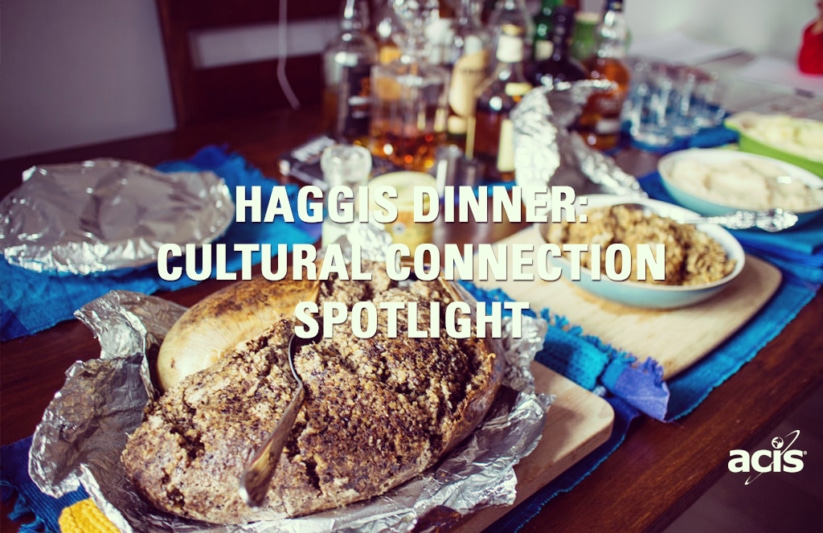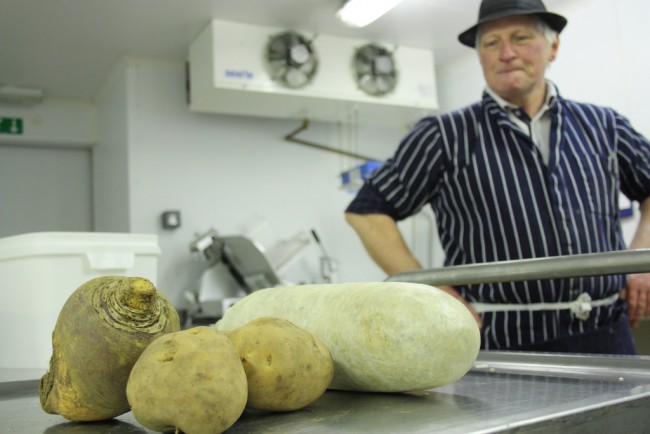Haggis Dinner: Cultural Connection Spotlight

There’s no better way to experience a foreign culture than through its native culinary tradition. There are many European countries where the food is the number one attraction, and then there’s Scotland, where Haggis is the national dish–a mix of sheep’s innards, oatmeal and spices, all wrapped up in a sheep stomach. While it may not sound like its ready to compete with France or Italy for Europe’s best regional cuisine, Scots throughout history have opined that you can’t knock Haggis until you try it.
One such Scot was National poet Robert Burns whose 1787 ode, Address to a Haggis, enshrined Haggis in Scottish cultural history. He wrote:
Address to a Haggis
Fair fa’ your honest, sonsie face, Fair and full is your honest, jolly face,
Great chieftain o the puddin’-race! Great chieftain of the sausage race!
Aboon them a’ ye tak your place, Above them all you take your place,
Painch, tripe, or thairm: Stomach, tripe, or intestines:
Weel are ye worthy o’ a grace Well are you worthy of a grace
As lang’s my arm. As long as my arm.
The groaning trencher there ye fill, The groaning trencher there you fill,
Your hurdies like a distant hill, Your buttocks like a distant hill,
Your pin wad help to mend a mill Your pin would help to mend a mill
In time o need, In time of need,
While thro your pores the dews distil While through your pores the dews distill
Like amber bead. Like amber bead.
His knife see rustic Labour dight, His knife see rustic Labour wipe,
An cut you up wi ready slight, And cut you up with ready slight,
Trenching your gushing entrails bright, Trenching your gushing entrails bright,
Like onie ditch; Like any ditch;
And then, O what a glorious sight, And then, O what a glorious sight,
Warm-reekin, rich! Warm steaming, rich!
Then, horn for horn, they stretch an strive: Then spoon for spoon, the stretch and strive:
Deil tak the hindmost, on they drive, Devil take the hindmost, on they drive,
Till a’ their weel-swall’d kytes belyve Till all their well swollen bellies by-and-by
Are bent like drums; Are bent like drums;
The auld Guidman, maist like to rive, Then old head of the table, most like to burst,
‘Bethankit’ hums. ‘The grace!’ hums.
Is there that owre his French ragout, Is there that over his French ragout,
Or olio that wad staw a sow, Or olio that would sicken a sow,
Or fricassee wad mak her spew Or fricassee would make her vomit
Wi perfect scunner, With perfect disgust,
Looks down wi sneering, scornfu view Looks down with sneering, scornful view
On sic a dinner? On such a dinner?
Poor devil! see him owre his trash, Poor devil! see him over his trash,
As feckless as a wither’d rash, As feeble as a withered rush,
His spindle shank a guid whip-lash, His thin legs a good whip-lash,
His nieve a nit; His fist a nut;
Thro bloody flood or field to dash, Through bloody flood or field to dash,
O how unfit! O how unfit.
But mark the Rustic, haggis-fed, But mark the Rustic, haggis-fed,
The trembling earth resounds his tread, The trembling earth resounds his tread,
Clap in his walie nieve a blade, Clap in his ample fist a blade,
He’ll make it whissle; He’ll make it whistle;
An legs an arms, an heads will sned, And legs, and arms, and heads will cut off
Like taps o thrissle. Like the heads of thistles.
Ye Pow’rs, wha mak mankind your care, You powers, who make mankind your care,
And dish them out their bill o fare, And dish them out their bill of fare,
Auld Scotland wants nae skinking ware Old Scotland wants no watery stuff,
That jaups in luggies: That splashes in small wooden dishes;
But, if ye wish her gratefu prayer, But if you wish her grateful prayer,
Gie her a Haggis Give her [Scotland] a Haggis!
Burns lent his celebrity to haggis and its popularity soon soared. After Burns’ death, a group of his friends began commemorating him every year on his birthday, January 25, and so began the “Burns Supper” tradition. The suppers continue to this day, featuring Scottish food, Scotch whiskey and a grand presentation of the haggis to the assembled guests.
Food historians agree. historically haggis was a peasant food. Encasing hard-to-cook cuts like lungs and intestines along with undesirable muscle meats like liver and kidneys into a convenient stomach packaging would have been a wonderful way to feed a group—while making sure no meat went to waste. Popular folklore has provided some notions as to Haggis’ origins.
In the days of the old Scottish cattle drovers, when the men left the Highlands to drive their cattle to market in Edinburgh the women would prepare rations for them to eat during the long journey down through the glens. They used the ingredients that were most readily available in their homes and conveniently packaged them in a sheep’s stomach allowing for easy transportation during the journey. Other speculations have been based on Scottish slaughtering practices. When a chieftain or laird required an animal to be slaughtered for meat (whether sheep or cattle) the workmen were allowed to keep the offal as their share.
Haggis ranges in price and quality. One can find it in a fancy establishment or a fast-food restaurant deep fried in batter with chips to comprise a “haggis supper”. You can find “haggis pakoras” in some Indian restaurants in Scotland. You can find it in most supermarkets or order it as an ingredient on pizza.
Haggis is event used in a sport in Scotland called haggis hurling where competitors throw haggis as far as possible. The world record for haggis hurling was achieved by Lorne Coltart on June 11, 2011, who hurled his haggis 217 ft. On October 8, 2008, competitive eater Eric “Steakbellie” Livingston set a world record by consuming 3 lbs of haggis in 8 minutes.
If you’re an ambitious culinary adventurer, and you’d like to give making your own batch of haggis a shot, here’s a recipe courtesy of Alton Brown:
Ingredients
1 sheep stomach
1 sheep liver
1 sheep heart
1 sheep tongue
1/2 pound suet, minced
3 medium onions, minced
1/2 pound dry oats, toasted
1 teaspoon kosher salt
1/2 teaspoon ground black pepper
1 teaspoon dried ground herbs
Directions
Rinse the stomach thoroughly and soak overnight in cold salted water.
Rinse the liver, heart, and tongue. In a large pot of boiling, salted water, cook these parts over medium heat for 2 hours. Remove and mince. Remove any gristle or skin and discard.
In a large bowl, combine the minced liver, heart, tongue, suet, onions, and toasted oats. Season with salt, pepper, and dried herbs. Moisten with some of the cooking water so the mixture binds. Remove the stomach from the cold salted water and fill 2/3 with the mixture. Sew or tie the stomach closed. Use a turning fork to pierce the stomach several times. This will prevent the haggis from bursting.
In a large pot of boiling water, gently place the filled stomach, being careful not to splash. Cook over high heat for 3 hours.
Serve with mashed potatoes.
Check out the complete itinerary for Rule Britannia, our tour featuring a traditional haggis dinner in Edinburgh along with visits to London, York, and Stratford-upon-Avon!
FREE GUIDE
5 Trips for English Teachers
Interested in trips specifically designed for English Teachers? This Free Guide
includes 5 itineraries that make the world of English literature come alive.











